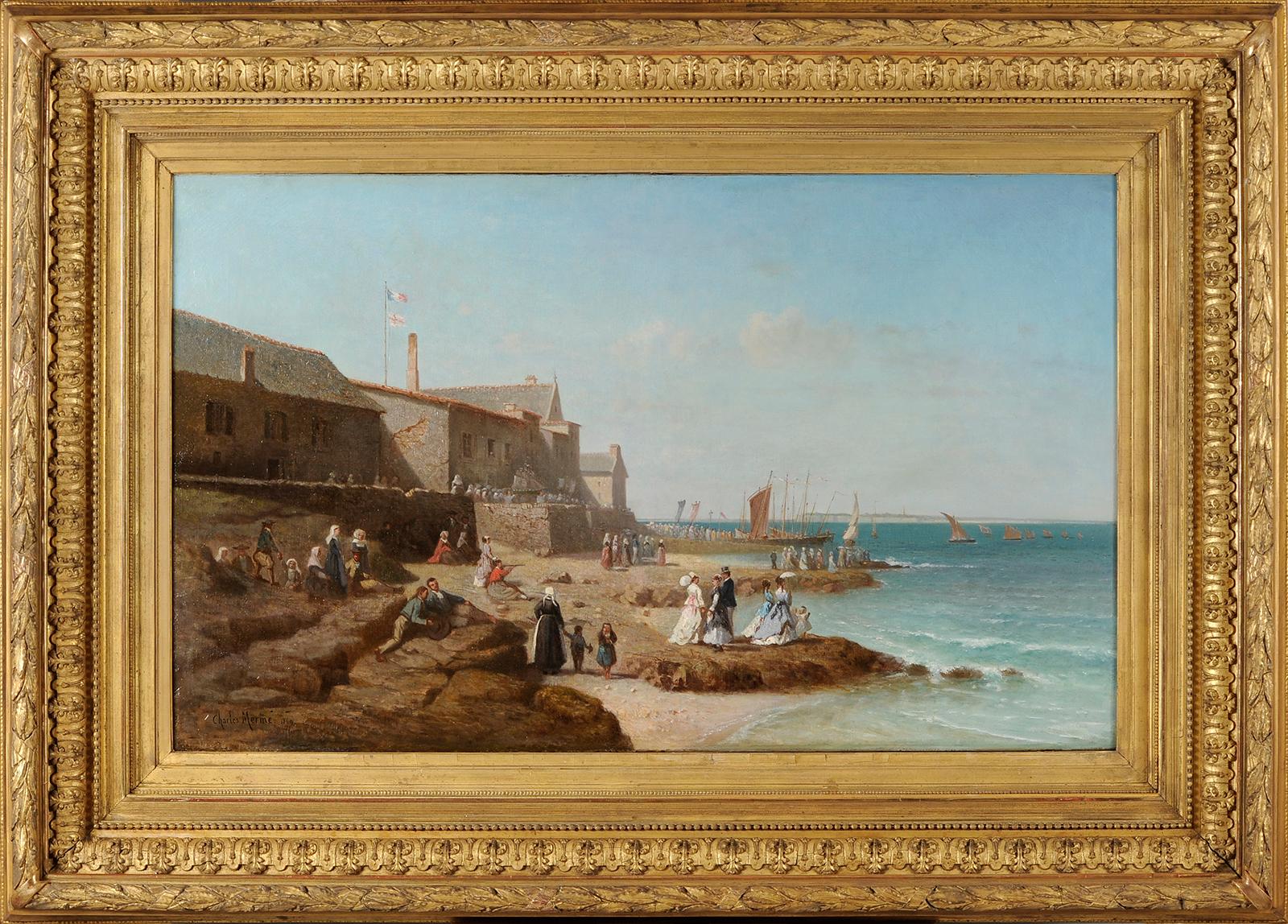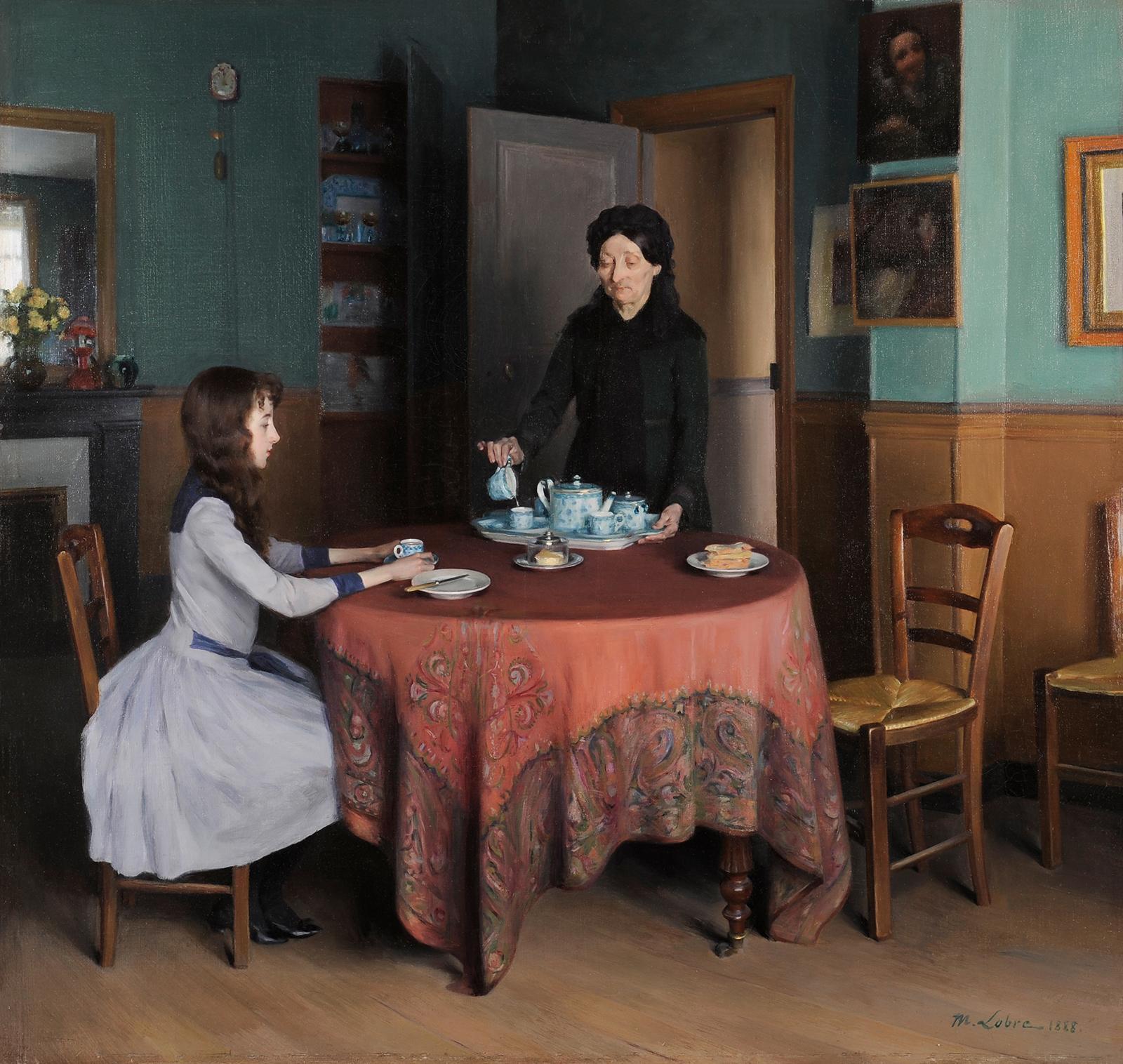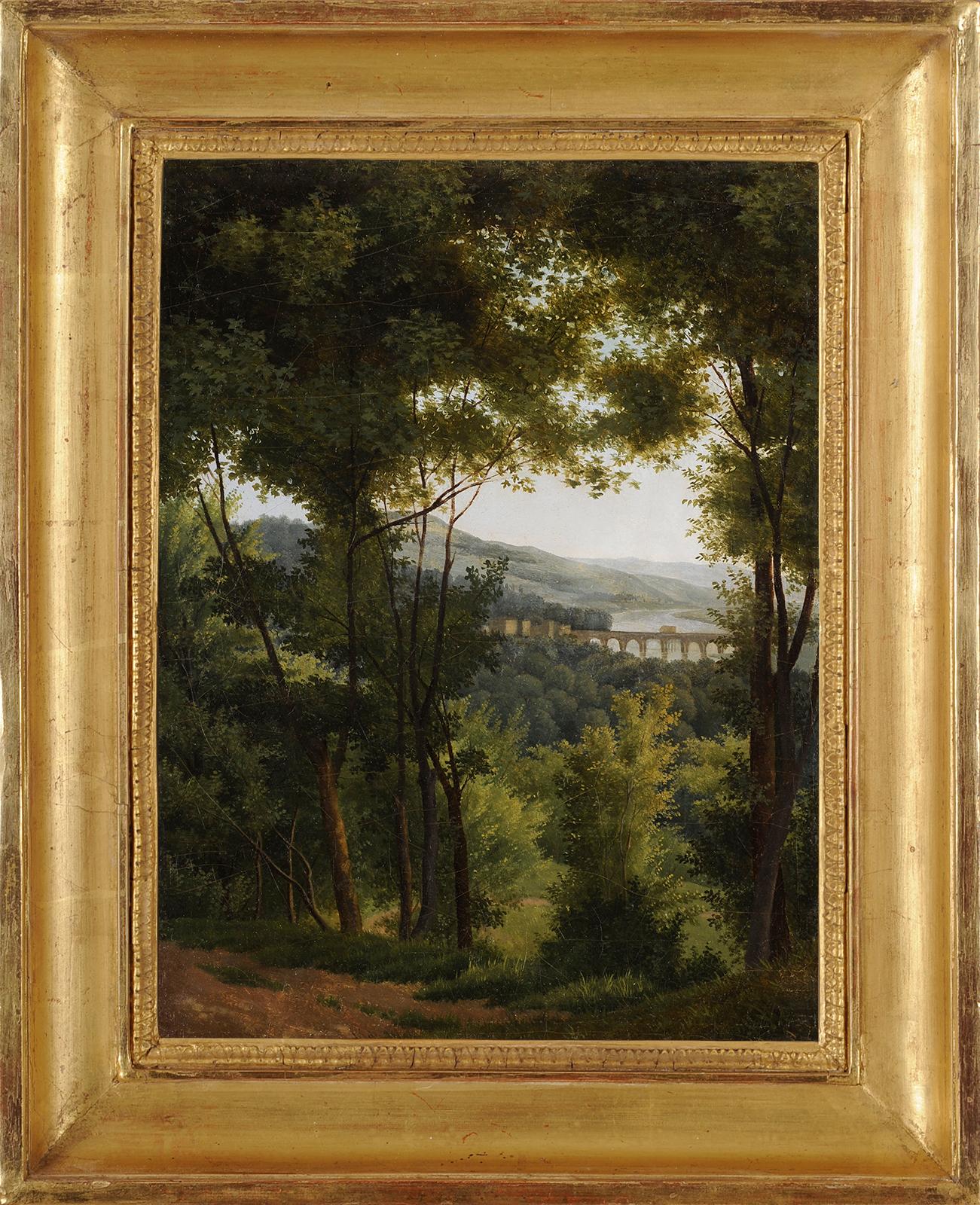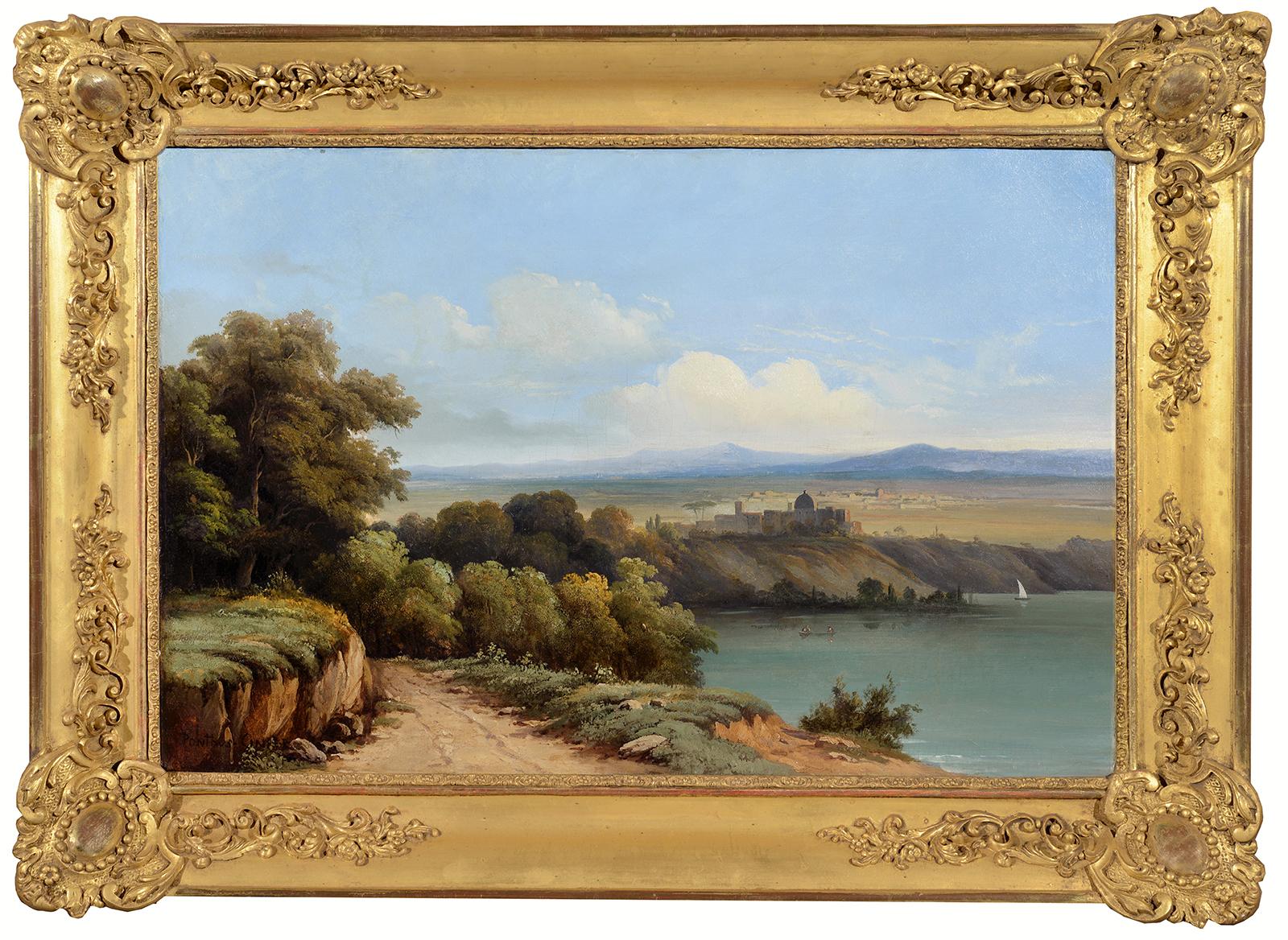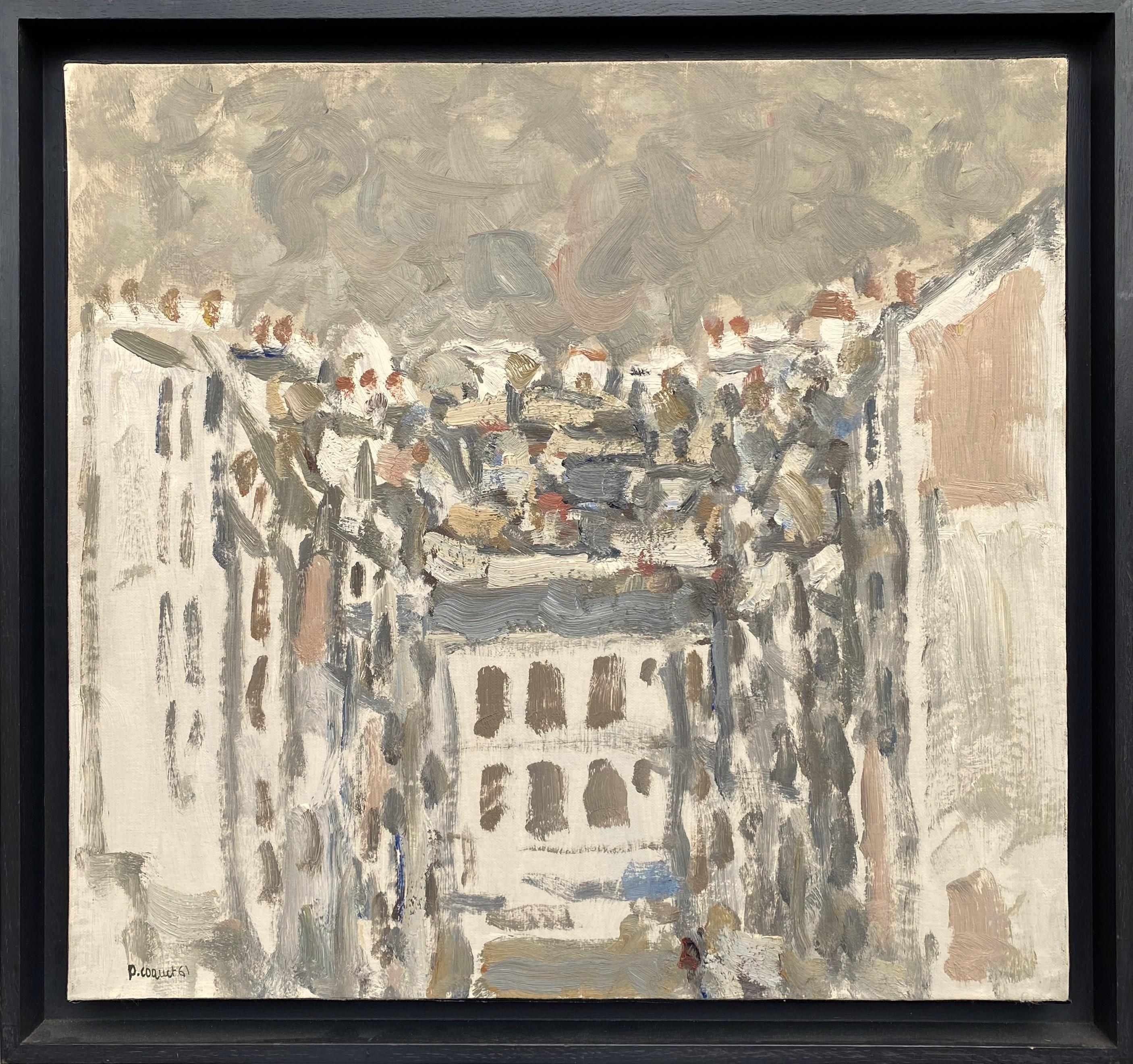Items Similar to Circle of Xavier Leprince - Picnic in the forest
Want more images or videos?
Request additional images or videos from the seller
1 of 9
Circle of Xavier Leprince - Picnic in the forest1825
1825
About the Item
Circle of Xavier LEPRINCE
(Paris 1799 - Nice 1826)
Picnic in the forest
Oil on canvas
H. 36 cm; L. 26 cm
This picnic scene places us around 1825/35, which makes it a rare representation of such a subject in the first years of its popularization. Here we see a family seated in the undergrowth where even a dog has the right to approach its muzzle. We can clearly see the basket and a bundle used to carry the food to the edge of this stream. On the right of the composition, a man returns carrying a basket of bottles that he had left to cool in this stream.
This composition is to be compared to the works of painter such as Bertin, Dunouy, and especially Xavier Leprince, accustomed to works animated by characters.
- Creation Year:1825
- Dimensions:Height: 14.18 in (36 cm)Width: 10.24 in (26 cm)
- Medium:
- Movement & Style:
- Circle Of:Xavier Leprince (1799 - 1826, French)
- Period:
- Condition:Perfect condition. Cleaned.
- Gallery Location:BELEYMAS, FR
- Reference Number:1stDibs: LU1860212288482
About the Seller
No Reviews Yet
Vetted Seller
These experienced sellers undergo a comprehensive evaluation by our team of in-house experts.
Established in 2011
1stDibs seller since 2022
- ShippingRetrieving quote...Ships From: BELEYMAS, France
- Return PolicyThis item cannot be returned.
More From This SellerView All
- Charles Merme (1818-1869) The blessing of Coureau de Groix in Larmor BrittanyLocated in BELEYMAS, FRCharles MERMÉ (Cherbourg 1818 - Lorient 1869) The blessing of Coureau de Groix at Larmor Oil on canvas H. 60 cm; W. 100 cm Signed and dated lower left, 1...Category
1860s French School Figurative Paintings
MaterialsCanvas, Oil
- Maurice Lobre (1862 -1951) The snackBy Maurice LobreLocated in BELEYMAS, FRMaurice LOBRE (Bordeaux 1862 - Paris 1951) Le goûter Huile sur toile H. 87 cm ; L. 91,5 cm Format peint d’origine, H. 101 cm ; L. 96 cm, disposé sur un châssis plus petit par l’artiste lui-même. Signée et datée 1888 en bas à droite Provenance : Collection privée, Lyon Exposition : 1889, Salon des Artistes Français, n°1719 « Intérieur », (ou 1720 nommé également « Intérieur ») Œuvres en rapport : Le Cabinet de toilette de Jacques-Emile Blanche, (titre erroné) H. 80 cm ; L. 85 cm, HST, Museo Thyssen-Bornemisza, Madrid, pendant de notre toile. Maurice Lobre a-t-il connu Marcel Proust ? On ne peut encore l'affirmer, bien qu'il ait eu de nombreux amis en commun avec l'écrivain. Mais sa peinture intimiste pourrait illustrer certaines pages de Du côté de chez Swann. Trois citations dues à des proches de Proust, l'une de l'écrivain Léon Daudet, la seconde du peintre Jacques-Emile Blanche, la dernière du poète mondain Robert de Montesquiou, donnent un aperçu de ce que fut la renommée de Maurice Lobre en son temps : "Il en va autrement de Lobre, le Vermeer français, le peintre exquis des intérieurs et des palais de Versailles, des reflets sur les meubles rares, de la lumière prisonnière des miroirs, des laques et des cuivres polis. Lobre est joyeux comme un coup de vent, qui fait envoler les préjugés et les poncifs, éloquent, passionné, ivre de la couleur et des formes, charmant et conquérant de toutes les matières. Il se promène ici-bas ainsi que dans un musée en plein-air, s'amuse de tout, rejette et maudit le laid et le vil, accueille et bénit le beau et le bien…" Léon Daudet L'Entre-deux-guerres. Souvenirs des milieux littéraires, politiques, artistiques et médicaux de 1880 à 1905. "Voici le patient, appliqué, sage M. Lobre. Il est difficile de mettre plus d'honnêteté à peindre des intérieurs sans figures. Je préfère ses petits salons de Versailles à ses cathédrales… Nous lui devons des petits bijoux d'émotion et de large fini." Jacques-Emile Blanche "Il a recueilli sur des toiles le visage du vieux Versailles (…). Il a peuplé de visions impalpables des chambres " où il s'est passé quelque chose ", et il en a saturé l'atmosphère de particules historiques. Donner une telle impression avec certitude, avec vérité, c'est plus difficile que de faire évoluer des personnages costumés, dans ce qu'on appelle bêtement "une reconstitution historique"." Comte Robert de Montesquiou Maurice Lobre commence sa carrière au Salon de 1882 où il expose deux portraits, dont celui de son camarade de l'atelier Carolus-Duran, le peintre espagnol Ramon Casas...Category
1880s French School Figurative Paintings
MaterialsCanvas, Oil
- View taken in the Park of Saint-Cloud near ParisLocated in BELEYMAS, FRAlexandre-Hyacinthe DUNOUY (Paris, 1757 – Jouy en Josas, 1841) View taken in the park of Saint-Cloud Oil on paper mounted on canvas H. 31.5 cm; L. 24 cm Around 1820 Provenance: -Per...Category
1810s French School Figurative Paintings
MaterialsCanvas, Oil
- Lake Albano, Castel Gandolfo ItalyBy Antoine Ponthus-CinierLocated in BELEYMAS, FRAntoine-Claude PONTHUS-CINIER (Lyon, 1812 - Lyon, 1885) Lake Albano, Castel Gandolfo and the Roman countryside Oil on canvas mounted on cardboard H. 38 cm; L. 55 cm Signed lower left Ponthus-Cinier belongs to what could be defined as the third (and so to speak last) generation of neo-classical or historical landscape painters, born in the years 1810/1820, like Félix Lanoüe, Achille Bénouville...Category
1840s French School Figurative Paintings
MaterialsCanvas, Oil
- François-Edme Ricois (1795-1881) View of Châteaudun castle and city in FranceLocated in BELEYMAS, FRFrançois-Edme RICOIS (Courtalain, 1795 - Mareil-Marly, 1881) View of Châteaudun Oil on canvas H. 65 cm; W. 98 cm Signed and dated lower center 1860 François-Edme Ricois although bor...Category
1840s French School Figurative Paintings
MaterialsCanvas, Oil
- Henri Pailler - Snow in Triel sur SeineBy Henri PaillerLocated in BELEYMAS, FRHenri PAILLER (Poitiers 1876 - Triel-sur-Seine 1954) Snow in Triel sur Seine Oil on canvas H. 54 cm; L. 73 cm Signed lower left Provenance: Private collection, Vienne A native of Poitiers in Vienne, Henri Pailler shows serious drawing skills. Noticed by Edmond Petitjean, the young man was sent to Paris to complete his training at the Beaux-Arts under the aegis of the great Léon Bonnat. First of all accustomed to a style and a very academic palette, the young painter quickly branched off from this classical art which he hardly liked. From the beginning of the century he moved towards Impressionism which he deployed within the Crozant school thanks to his meeting with Armand Guillaumin who took him to paint on the motif in 1901. Residing in Poitiers until the At the dawn of the great conflict of 1914, Pailler sent to the Salon many landscapes of the Creuse where the liveliness of colors was more and more felt. It is precisely following the meeting with Dufy and Marquet that a fawn side appears in his compositions, but after a few years he instinctively returns to his love for impressionism by keeping a generous amount of hues on his palette. On his return from the war, Henri Pailler joined Roubaix where he was appointed workshop professor at the School of Industrial Arts. On his retirement he will settle on the banks of the Seine in Triel-sur-Seine, of which he will realize many views with the talent and the colors so appreciated by this painter considered to be one of the greats of Crozant. Throughout his career, Pailler will travel through France and regularly in Périgord, from which he will bring back many works by Bourdeilles mainly but also Brantôme. From the 1920s, the painter will present views of Triel-sur-Seine in the Yvelines in various salons. This town, whose church with its distinctive silhouette will be the playground for Pailler's easel until his death. Our painting undoubtedly made in the 1920s is a striking winter image...Category
1920s French School Figurative Paintings
MaterialsCanvas, Oil
You May Also Like
- View of Paris, oil painting by Pierre CoquetLocated in Montfort l’Amaury, FRReference number F367 The painting is framed with a dark grey wood floated frame. 50 x 53 cm frame included (45 x 48 cm without frame) This work is painted with oil on a canvas. It i...Category
1960s French School Figurative Paintings
MaterialsCanvas, Oil
- Guillaume-François Colson - Sur la plage, french, beach, 19th century, paintingLocated in London, GBGuillaume-François Colson (1785-1860) Sur la plage oil on canvas 35 x 65 cm signed 'Colson' (lower right) Price: £18,000 GBP Provenance: MacConnal-Mason Fine Paintings Private coll...Category
19th Century French School Landscape Paintings
MaterialsCanvas, Oil
- Pointillist Painting "The Road Beneath the Snow" Eugène Bégarat (French, 1943)By Eugène BégaratLocated in SANTA FE, NMPointillist Painting "The Road Beneath the Snow (Le Chemin Sous la Neige)" Eugène Bégarat (French, 1943) Oil on canvas 15 3/4 x 31 1/2 inches Saturated with winter's light glinting...Category
20th Century French School Landscape Paintings
MaterialsOil, Canvas
- A Soldier Blowing the Trumpet by French Artist Charles Bouchez, Oil on CanvasLocated in Stockholm, SECharles Bouchez (1811-1882) French A Soldier Blowing the Trumpet oil on canvas signed and dated ch. Bouchez 1842 canvas dimensions 6.29 x 4.13 inches (16 x 10.5 cm) frame 10.23 x 7...Category
1840s French School Figurative Paintings
MaterialsCanvas, Oil
- Henri-Jean Chasselat, Town Scene With Buildings, Horse, Wagon & FiguresLocated in Cheltenham, GBThis mid-19th-century oil painting by French artist Henri-Jean Chasselat (1813-1880) depicts a continental town scene. Four white horses, hitched to a covered wagon, wait patiently ...Category
1860s French School Landscape Paintings
MaterialsOil, Canvas
- Pair of Gallant Scenes - Oil on Canvas - 18th CenturyLocated in Roma, ITPair of Gallant scenes is a pair of artworks realized by the French School in 18th Century. Oil on canvas. It Includes 2 ancient gilded frames. Scen...Category
18th Century French School Figurative Paintings
MaterialsOil, Canvas
